Silent danger lurks

Courtesy state Department of Land and Natural Resources file
Researchers and land-management personnel from a variety of organizations gather together to learn about rapid ‘ohi‘a death detection and response.
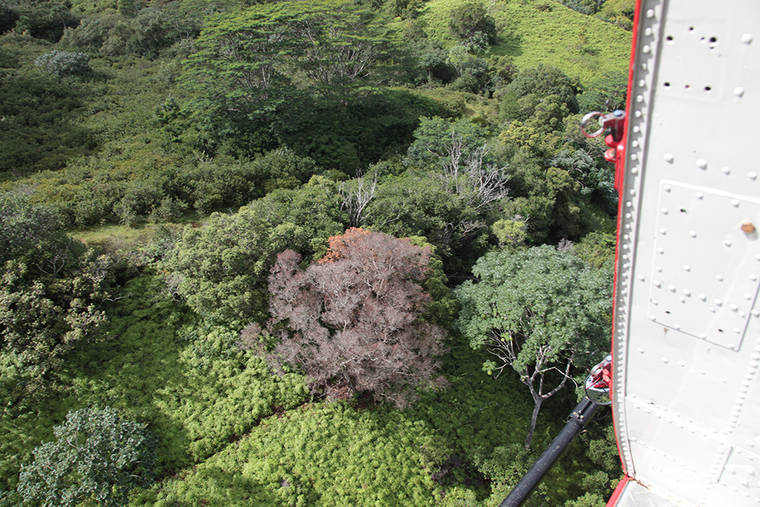
Kim S. Rogers / Kaua‘i Invasive Species Committee
A tree possibly infected by rapid ʻohiʻa death is seen from a helicopter during a survey of the disease’s possible spread on Kaua‘i.
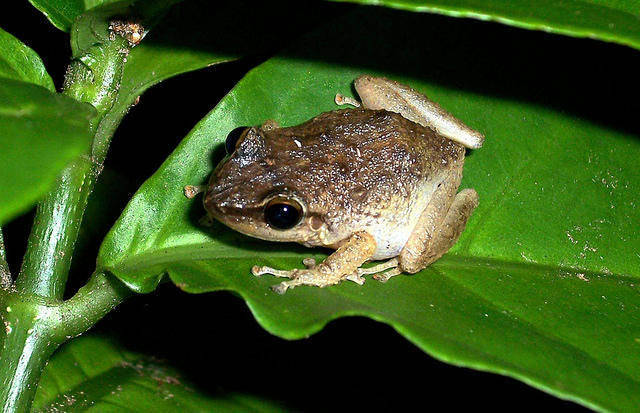
Kim S. Rogers / Kaua‘i Invasive Species Committee
The coqui frog is a small tree frog larger than 1 inch long. It has a round body shape. The coloration is variable from light yellow to dark brown, with broad rounded snouts with obvious toe pads. The frog has caused an estimated $3 million dollars in damages because it has no natural predators.
Kim Starr / Kaua‘i Invasive Species Committee
Miconia may be a familiar sight and name. The trees grow quickly and close together, shading out nearly all other forest plants with their large, oval leaves. It also has a shallow root system and can cause increased erosion and landslides. Miconia quickly matures, producing fruit after three to four years and flowers and fruits several times a year. Plants produce 10 to 20 million seeds a year, which can remain viable for 12 years and possibly longer.
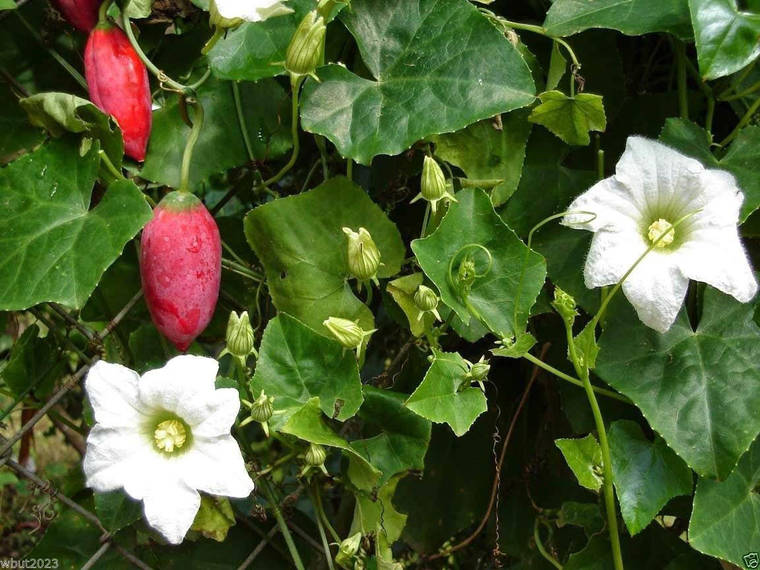
Courtesy Kaua‘i Invasive Species Committee
The ivy goard vines grow over and smother vegetation, and cover fences and power lines. It threatens natural and managed areas. It is extremely difficult to control because plants regrow from deep roots even after treatment with herbicide. Although ivy gourd requires cross-pollination between male and female plants, it is able to spread quickly and can grow up to four inches per day.
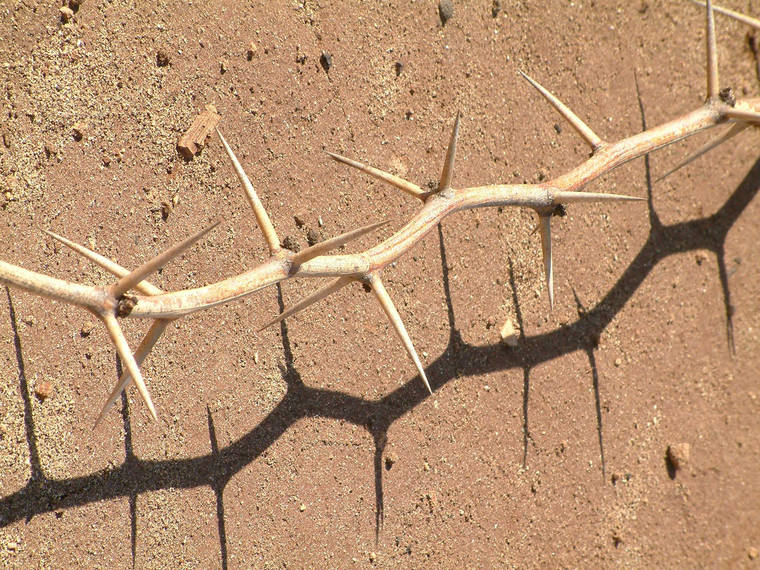
Courtesy Kaua‘i Invasive Species Committee
Long-thorn kiawe can grow as a rambling shrub or tree ranging from 6 feet to 30 feet tall. The thorns are up to 4 inches long. It’s pale yellow flowers are numerous, and grow in cylinder-shaped spikes up to 4 inches long. Mature seed pods are flat, curved, yellowish brown and 3 inches to 8 inches long.
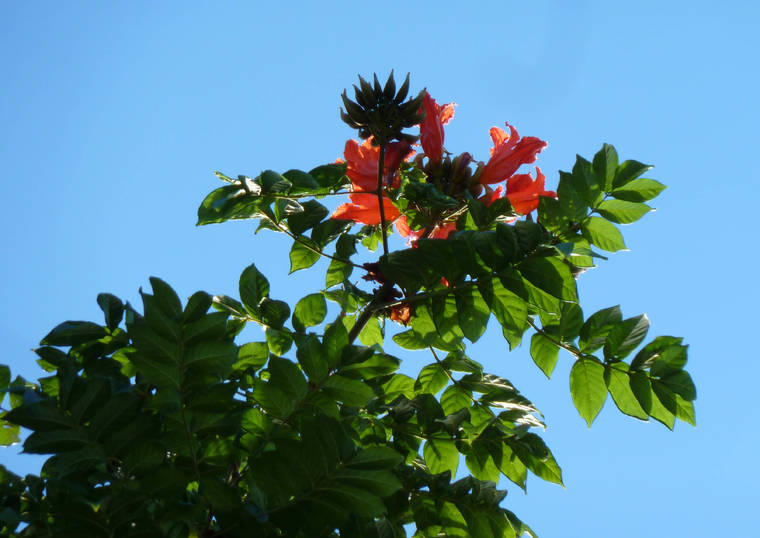
Courtesy Kauaʻi Invasive Species Committee
The African tulip, Spathodea campanulata, is an East African native which has been in Hawaiʻi for a long time. Renowned physician and botanist William Hillebrand first planted African tulip trees in Hawaiʻi in the late 1800s.
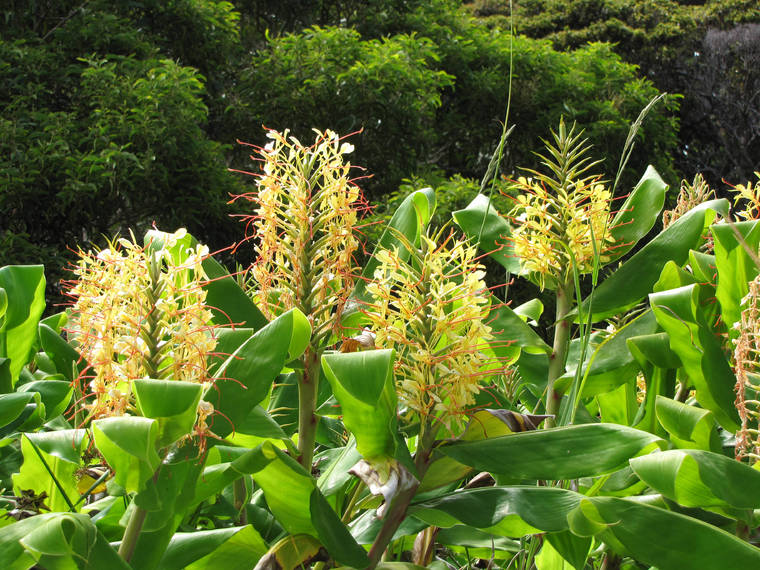
Kim Starr / Kaua‘i Invasive Species Committee
The fruit of Himalayan ginger is a tasty treat for non-native birds, but this means the seeds are spread throughout the forest.

Courtesy Kauaʻi Invasive Species Committee
False kava has a thick growth habit and spreading root suckers which displace other plants. Since it can be easily confused with true kava it is sometimes mistakenly interplanted, which then threatens the purity and preservation of true kava, vastly decreasing the value of the crop and the quality of the product. False kava does not have the same medicinal properties as true kava. False kava grows twice as fast as true kava and quickly takes over the habitat.
KAPAA The Kauai Invasive Species Committees mission continues to evolve with the ever-changing ecosystem, which the Kapaa-based nonprofit organization was built to protect.
KAPA‘A — The Kaua‘i Invasive Species Committee’s mission continues to evolve with the ever-changing ecosystem, which the Kapa‘a-based nonprofit organization was built to protect.
Two years ago was an example of a drastic change in the Kaua‘i environment.
The ‘ohi‘a death was detected on Kaua‘i by biologists in 2018, which is caused by two fungal pathogens, one more aggressive than the other, and can lead to the death of ‘ohi’a trees found on every island.
Hawai‘i enacted its response plan for the fight against rapid ‘ohi‘a death recently, calling for more than $20 million for research and to combat the disease over the next five years.
A work in progress
The outreach is part of a 10-year plan at the state and federal levels to continue to push forward all KISC initiatives, have more inspection facilities, conduct inspections of non-agricultural items, develop enhanced control of invasive species and continue to engage the community.
Project Manager Tiffani Keanini said the outreach is still a work in progress.
“We have focused outreach and education efforts on raising community awareness and involvement in bio-sanitation and decontamination practices that will help reduce the spread of rapid ‘ohi‘a death, as well as invasive seeds,” Keanini said.
“It’s a multi-agency collaborative effort, with boot-brush stations and educational signage installed at numerous trailheads and destinations around the island,” she said.
The fungi attacking the ‘ohi‘a are just two invasive species affecting Kaua‘i.
KISC is partners with the state Department of Agriculture, which leads rapid-response teams concerning brown tree snakes, and also assists with coqui frogs, which are frogs native to Puerto Rico with fast reproduction rates and no natural predators in Hawai‘i.
Reports state the common coqui currently costs the state nearly $3 million a year.
Keanini credited cooperation from the Kaua‘i community for their awareness in helping stop the frog’s reproduction on the island.
For KISC and other partnerships to continue to have success in their attempt to eradicate invasive species, they must continue to get help at the state legislative level.
“Legislation concerning increasing both statewide and island-wide rapid-response capacity, including bio-security, community awareness and research relating to invasive species, is all-important for Kaua’i,” Keanini said.
Making moves
There is a proposed program to increase the number of non-invasive trees in the state, according to a recent press release published in The Garden Island.
The state Legislature is considering backing the tree-planting project started by the University of Hawai‘i geography professor Camilo Mora to offset carbon emissions, the Honolulu Star-Advertiser reported.
The most recent project involved 2,000 volunteers planting 11,000 trees in December, Mora said, adding that he hopes to increase that to 100,000 this year and a million in 2021.
The bill would place the state Department of Land and Natural Resources in charge of a program to plant a million native trees statewide each year. It was approved by the state Senate and passed its first reading in the state House.
Democratic state Sen. Donovan Dela Cruz introduced the bill, adding that trees could provide shade, combat invasive species and restore the state’s ecosystem.
“There are so many reasons why that makes sense, and the more we can plant native trees so that we can perpetuate our indigenous ecosystems, that help keeps Hawai‘i unique,” Dela Cruz said in a written statement.
A growing concern for a growing industry
The attempt to eradicate money allocated to study invasive species and to educate the general public has become an industry in itself.
Hawai‘i is climate-conducive for several non-native species to survive, and has kept KISC, state legislators and academia on both a state and federal level constantly reformulating a plan to try to defend the island’s delicate ecosystems.
“Hawai’i has many different climate zones, making it possible for a wide range of species to invade at different elevations and climates,” said Daniel Rubinoff, a professor of entomology, director of the University of Hawai‘i Insect Museum and an expert on invasive species in the state.
“Feral pigs and feral goats on Kaua‘i have damaged ecosystems tremendously. They preferentially destroy native forests, exterminate native plants and the insects that feed on them, and facilitate the invasion of mosquitoes, which then eliminate the remaining native Hawaiian honeycreepers and other native birds,” he said.
Rubinoff stated there is no way you quantify the economic impact of the estimated 4,000 invasive species that have invaded the islands of Hawai‘i over the years.
He said the financial loss is significant.
“It depends on how you calculate this,” Rubinoff said. “It can be based on the loss of crops to native forests or siltation of the reefs because of erosion and then the loss of fish. Millions of dollars are lost in a variety of ways, and some are less easy to calculate.”
Federal funding to combat species like the rosy wolf snails from Florida and African snails in Hawai‘i in the early ‘50s, wasn’t highly successful, Rubinoff said.
When these projects fail to succeed, they can be detrimental to the economy and the ecosystem.
“The rosy wolf snails eliminated many endemic species of tree snails and land snails from across Hawai‘i,” Rubinoff said. “The (attempt to eradicate them) was a disaster.”
The evolution
Christy Martin is the public information officer and program manager at The Pacific Cooperative Studies Unit/Coordinating Group on Alien Pest Species. As program manager of the group based at the University of Hawai‘i in Manoa, she has been involved with invasive species since 2000.
“I’ve seen 20 years of progress,” Martin said.
Martin, who admitted she never envisioned herself involved with community outreach since moving away from being a marine biology teacher, has become immersed in it.
“We have come a long way, and having people aware of recognizing invasive species and the term is even progress,” Martin said.
“We have a lot more people in Hawai‘i that are aware of the issue.
“I have seen public polling on this issue, and I am thrilled that people recognize this as a somewhat-serious issue that needs to translate into action now. There have been a lot of changes,” she said.
Fortunately for issues like invasive species, there isn’t a lot of controversy on where the money should be allocated to combat this problem.
“There is not a disagreement where federal or state funding should go,” Martin said. “The rapid ‘ohi‘a tree is the most important native tree we have in Hawai‘i. People need to work together seamlessly. It is the sort of energy required in fighting invasive species, and we need more leadership behind this to push this.”
•••
Jason Blasco, sports reporter, can be reached at 245-0437 or jblasco@thegardenisland.com.


“The attempt to eradicate money allocated to study invasive species and to educate the general public has become an industry in itself.”
–was this a mangled cut-and-paste? I hope nobody is trying to eradicate the allocation of money to this project!